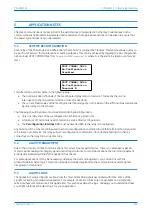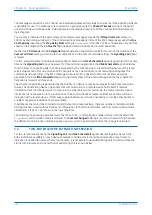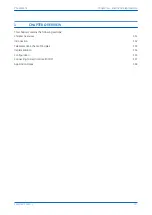
7
APPLICATION NOTES
Electrical InterMiCOM settings are contained within two columns; INTERMICOM COMMS and INTERMICOM CONF.
The INTERMICOM COMMS column contains all the settings needed to configure the communications, as well as the
channel statistics and diagnostic facilities. The INTERMICOM CONF column sets the mode of each command signal
and defines how they operate in case of signalling failure.
Short metallic direct connections and connections using fire-optic converters will generally be set to have the
highest signalling speed of 19200b/s. Due to this high signalling rate, the difference in operating time between the
direct, permissive, and blocking type signals is small. This means you can select the most secure signalling
command type (‘Direct’ intertrip) for all commands. You do this with the IM# Cmd Type settings. For these
applications you should set the IM# Fallback Mode to
Default
. You should also set a minimal intentional delay
by setting IM# FrameSyncTim to 10 msecs. This ensures that whenever two consecutive corrupt messages are
received, the command will immediately revert to the default value until a new valid message is received.
For applications that use Modem and/or multiplexed connections, the trade-off between speed, security, and
dependability is more critical. Choosing the fastest baud rate (data rate) to achieve maximum speed may appear
attractive, but this is likely to increase the cost of the telecommunications equipment. Also, telecommunication
services operating at high data rates are more prone to interference and suffer from longer re-synchronisation
times following periods of disruption. Taking into account these factors we recommend a maximum baud rate
setting of 9600 bps. As baud rates decrease, communications become more robust with fewer interruptions, but
overall signalling times increase.
At slower baud rates, the choice of signalling mode becomes significant. You should also consider what happens
during periods of noise when message structure and content can be lost.
●
In ‘Blocking’ mode, the likelihood of receiving a command in a noisy environment is high. In this case, we
recommend you set IM# Fallback Mode to
Default
, with a reasonably long IM# FrameSyncTim setting.
Set IM# DefaultValue to ‘1’. This provides a substitute for a received blocking signal, applying a failsafe for
blocking schemes.
●
In ‘Direct’ mode, the likelihood of receiving commands in a noisy environment is small. In this case, we
recommend you set IM# Fallback Mode to
Default
with a short IM# FrameSyncTim setting. Set IM#
DefaultValue to ‘0’. This means that if a corrupt message is received, InterMiCOM will use the default value.
This provides a substitute for the intertrip signal not being received, applying a failsafe for direct
intertripping schemes.
●
In ‘Permissive’ mode, the likelihood of receiving a valid command under noisy communications conditions is
somwhere between that of the ‘Blocking’ mode and the ‘Direct’ intertrip mode. In this case, we
recommended you set IM# Fallback Mode to
Latched
.
The table below presents recommended IM# FrameSyncTim settings for the different signalling modes and baud
rates:
Minimum Recommended "IM# FrameSyncTim" Setting
Baud Rate
Direct Intertrip Mode
Blocking Mode
Minimum Setting
(ms)
Maximum Setting
(ms)
600
100
250
100
1500
1200
50
130
50
1500
2400
30
70
30
1500
4800
20
40
20
1500
9600
10
20
10
1500
19200
10
10
10
1500
Chapter 16 - Electrical Teleprotection
P54A/B/C/E
338
P54xMED-TM-EN-1
Summary of Contents for P4A
Page 2: ......
Page 20: ...Contents P54A B C E xviii P54xMED TM EN 1 ...
Page 27: ...CHAPTER 1 INTRODUCTION ...
Page 28: ...Chapter 1 Introduction P54A B C E 2 P54xMED TM EN 1 ...
Page 38: ...Chapter 1 Introduction P54A B C E 12 P54xMED TM EN 1 ...
Page 39: ...CHAPTER 2 SAFETY INFORMATION ...
Page 40: ...Chapter 2 Safety Information P54A B C E 14 P54xMED TM EN 1 ...
Page 52: ...Chapter 2 Safety Information P54A B C E 26 P54xMED TM EN 1 ...
Page 53: ...CHAPTER 3 HARDWARE DESIGN ...
Page 54: ...Chapter 3 Hardware Design P54A B C E 28 P54xMED TM EN 1 ...
Page 86: ...Chapter 3 Hardware Design P54A B C E 60 P54xMED TM EN 1 ...
Page 87: ...CHAPTER 4 SOFTWARE DESIGN ...
Page 88: ...Chapter 4 Software Design P54A B C E 62 P54xMED TM EN 1 ...
Page 99: ...CHAPTER 5 CONFIGURATION ...
Page 100: ...Chapter 5 Configuration P54A B C E 74 P54xMED TM EN 1 ...
Page 120: ...Chapter 5 Configuration P54A B C E 94 P54xMED TM EN 1 ...
Page 121: ...CHAPTER 6 CURRENT DIFFERENTIAL PROTECTION ...
Page 122: ...Chapter 6 Current Differential Protection P54A B C E 96 P54xMED TM EN 1 ...
Page 149: ...CHAPTER 7 AUTORECLOSE ...
Page 150: ...Chapter 7 Autoreclose P54A B C E 124 P54xMED TM EN 1 ...
Page 207: ...CHAPTER 8 CB FAIL PROTECTION ...
Page 208: ...Chapter 8 CB Fail Protection P54A B C E 182 P54xMED TM EN 1 ...
Page 219: ...CHAPTER 9 CURRENT PROTECTION FUNCTIONS ...
Page 220: ...Chapter 9 Current Protection Functions P54A B C E 194 P54xMED TM EN 1 ...
Page 244: ...Chapter 9 Current Protection Functions P54A B C E 218 P54xMED TM EN 1 ...
Page 247: ...CHAPTER 10 VOLTAGE PROTECTION FUNCTIONS ...
Page 248: ...Chapter 10 Voltage Protection Functions P54A B C E 222 P54xMED TM EN 1 ...
Page 261: ...CHAPTER 11 FREQUENCY PROTECTION FUNCTIONS ...
Page 262: ...Chapter 11 Frequency Protection Functions P54A B C E 236 P54xMED TM EN 1 ...
Page 268: ...Chapter 11 Frequency Protection Functions P54A B C E 242 P54xMED TM EN 1 ...
Page 269: ...CHAPTER 12 MONITORING AND CONTROL ...
Page 270: ...Chapter 12 Monitoring and Control P54A B C E 244 P54xMED TM EN 1 ...
Page 300: ...Chapter 12 Monitoring and Control P54A B C E 274 P54xMED TM EN 1 ...
Page 301: ...CHAPTER 13 SUPERVISION ...
Page 302: ...Chapter 13 Supervision P54A B C E 276 P54xMED TM EN 1 ...
Page 312: ...Chapter 13 Supervision P54A B C E 286 P54xMED TM EN 1 ...
Page 323: ...CHAPTER 14 DIGITAL I O AND PSL CONFIGURATION ...
Page 324: ...Chapter 14 Digital I O and PSL Configuration P54A B C E 298 P54xMED TM EN 1 ...
Page 336: ...Chapter 14 Digital I O and PSL Configuration P54A B C E 310 P54xMED TM EN 1 ...
Page 337: ...CHAPTER 15 FIBRE TELEPROTECTION ...
Page 338: ...Chapter 15 Fibre Teleprotection P54A B C E 312 P54xMED TM EN 1 ...
Page 354: ...Chapter 15 Fibre Teleprotection P54A B C E 328 P54xMED TM EN 1 ...
Page 355: ...CHAPTER 16 ELECTRICAL TELEPROTECTION ...
Page 356: ...Chapter 16 Electrical Teleprotection P54A B C E 330 P54xMED TM EN 1 ...
Page 366: ...Chapter 16 Electrical Teleprotection P54A B C E 340 P54xMED TM EN 1 ...
Page 367: ...CHAPTER 17 COMMUNICATIONS ...
Page 368: ...Chapter 17 Communications P54A B C E 342 P54xMED TM EN 1 ...
Page 439: ...CHAPTER 18 CYBER SECURITY ...
Page 440: ...Chapter 18 Cyber Security P54A B C E 414 P54xMED TM EN 1 ...
Page 457: ...CHAPTER 19 INSTALLATION ...
Page 458: ...Chapter 19 Installation P54A B C E 432 P54xMED TM EN 1 ...
Page 471: ...CHAPTER 20 COMMISSIONING INSTRUCTIONS ...
Page 472: ...Chapter 20 Commissioning Instructions P54A B C E 446 P54xMED TM EN 1 ...
Page 513: ...CHAPTER 21 MAINTENANCE AND TROUBLESHOOTING ...
Page 514: ...Chapter 21 Maintenance and Troubleshooting P54A B C E 488 P54xMED TM EN 1 ...
Page 530: ...Chapter 21 Maintenance and Troubleshooting P54A B C E 504 P54xMED TM EN 1 ...
Page 531: ...CHAPTER 22 TECHNICAL SPECIFICATIONS ...
Page 532: ...Chapter 22 Technical Specifications P54A B C E 506 P54xMED TM EN 1 ...
Page 558: ...Chapter 22 Technical Specifications P54A B C E 532 P54xMED TM EN 1 ...
Page 559: ...APPENDIX A ORDERING OPTIONS ...
Page 560: ...Appendix A Ordering Options P54A B C E P54xMED TM EN 1 ...
Page 565: ...APPENDIX B SETTINGS AND SIGNALS ...
Page 566: ...Appendix B Settings and Signals P54A B C E P54xMED TM EN 1 ...
Page 790: ...Appendix B Settings and Signals P54A B C E B224 P54xMED TM EN 1 ...
Page 835: ...APPENDIX C WIRING DIAGRAMS ...
Page 836: ...Appendix C Wiring Diagrams P54A B C E P54xMED TM EN 1 ...
Page 849: ......






























